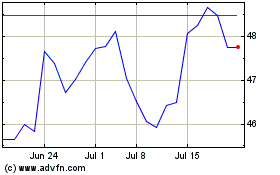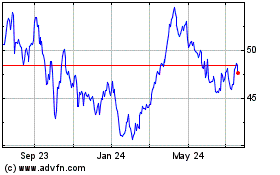By David Hodari and Ryan Dezember
Oil prices climbed sharply Thursday as tensions mounted in the
Middle East and the dollar fell, extending a period of high
volatility for crude.
West Texas Intermediate futures rose 5.4% to $56.65 a barrel on
the New York Mercantile Exchange, the biggest daily gain since
December. Brent crude, the global benchmark, was up 4.3% at $64.45
a barrel on London's ICE Futures exchange.
Shares of U.S. oil producers, rig operators, pipelines owners
and refiners also rallied, leading the S&P 500 higher to close
at a record. Energy shares in the stock index were up 2.2%, while
those in the S&P 600 index of smaller companies climbed
4.4%.
Energy stocks have been among the poorest performers of 2019,
but turmoil in the Middle East has recently lured back investors,
who are betting that domestic producers will grab global market
share from the Organization for Petroleum Exporting Countries.
Among the big gainers Thursday were producers Noble Energy Inc. and
Devon Energy Corp., up 6.1% and 4.3%, respectively, and refiner
HollyFrontier Corp., which added 5.4%. Oilfield services firm
Halliburton Co. gained 4.9%.
Iran's Revolutionary Guard said early Thursday it had shot down
a U.S. drone over its territory. That claim came hours after the
U.S. military said a Saudi desalination plant was struck by a
missile that appeared to come from Yemen.
"The market has been largely underpricing ongoing Middle Eastern
tension for some time now, but these growing tensions between Iran
and the U.S., and Iran and the Saudis bring it back to center stage
for many of us," said Warren Patterson, commodities strategist at
ING.
These developments mark the latest in a series of flashpoints in
the Middle East, with hostilities ratcheting up over recent weeks.
Saudi Arabia and the U.S. are on one side. Iran and Houthi Yemenis
are on the other.
Oil prices received a sharp boost last week, after attacks on
two tankers in the Gulf of Oman, which neighbors the Strait of
Hormuz -- the thoroughfare for a third of the world's shipped oil.
In May, prices jumped after attacks on Saudi pumping stations and
its East-West pipeline.
Hostility between Saudi Arabia and Iran has come against the
backdrop of U.S. sanctions aimed at driving Iranian oil exports to
zero. Iran has attempted to evade those strictures, while also
repeatedly threatening to shut down the Strait of Hormuz if
sanctions aren't lifted.
"Each time we've had an attack in the Middle East -- we've now
had a drone downed -- we've seen prices reacting positively," said
Giovanni Staunovo, director at UBS Wealth Management's chief
investment office. "But the risk premium will only stay if it risks
production disruptions and so far we've seen none."
Flare-ups in the region have added to volatility in oil prices,
providing shocks boosts in a period of anxiety over the health of
global economic growth.
The International Energy Agency, the Energy Information
Administration, and OPEC have all recently said that weakening
growth -- partly driven by the U.S.-China trade spat -- would
stymie oil demand in the coming months.
EIA data released Wednesday showed a larger-than-expected weekly
decline in U.S. crude inventories as well as record gasoline
demand, and a generally weaker economic backdrop has prompted
policy reaction this week from central banks. The European Central
Bank signaled possible stimulus measures Wednesday, while Federal
Reserve Chairman Jerome Powell signaled increasing willingness
Thursday to cut interest rates this year or next.
The ensuing drop in the dollar has helped buoy
dollar-denominated commodities, which become less expensive for
other currency holders when the dollar falls. The WSJ Dollar Index
was down 0.5% on the day, extending its decline over the past month
to 1.3%.
"There's also an economic part to the story, with the weakening
dollar obviously bullish for oil," said Tamas Varga, an analyst at
PVM Oil Associates.
A cocktail of geopolitical and fundamental factors threaten to
inject further volatility into oil over the coming days.
President Trump and China's President Xi Jinping are due to meet
at the G-20 summit in Japan next week. After trade talks broke down
several weeks ago, even the announcement of their plan prompted
buying across equities and commodities markets.
"If there's a break in the trade war, stocks and oil are going
to rally, " said Mr. Varga.
Separately, OPEC altered the dates of its coming meeting
Wednesday. With the bloc and its allies having finally agreed to
meet July 1-2, investor focus has returned to whether the cartel
will extend its continuing production cut. United Arab Emirates Oil
Minister Suhail al-Mazroui said Wednesday that a longer cut would
be reasonable, according to reports.
Meanwhile, U.S. natural gas prices plumbed new three-year lows,
with futures falling 4% to $2.185 per million British thermal
units, after the EIA reported greater injections into storage than
expected by analysts. Unseasonably mild weather has limited demand
for electricity to power air conditioners while the recent rise in
crude prices portends more gas produced as a byproduct of oil
drilling.
--Ryan Dezember contributed to this article.
Write to David Hodari at David.Hodari@dowjones.com and Ryan
Dezember at ryan.dezember@wsj.com
(END) Dow Jones Newswires
June 20, 2019 16:49 ET (20:49 GMT)
Copyright (c) 2019 Dow Jones & Company, Inc.
Devon Energy (NYSE:DVN)
Historical Stock Chart
From Mar 2024 to Apr 2024

Devon Energy (NYSE:DVN)
Historical Stock Chart
From Apr 2023 to Apr 2024
